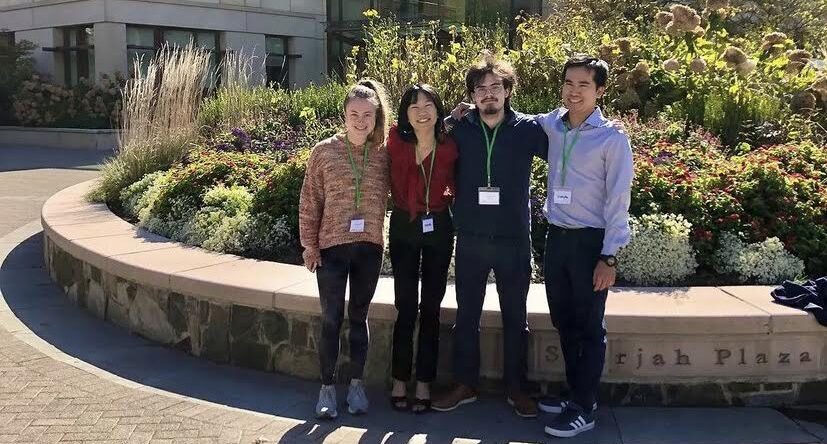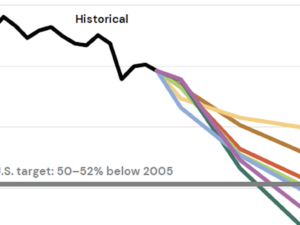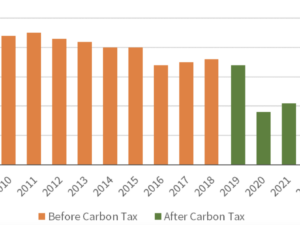
Katharine Gage, Emily O’Keefe and other CCLers at the United States’ Local Conference of Youth in Dubai
National Youth Climate Statement calls for carbon pricing
By Steffanie Munguía
In October, we shared with you that seven of our campus leaders had been selected to participate in the United States’ Local Conference of Youth (LCOY). As our CCL delegation heads to COP28 in Dubai, we sat down with three of these young leaders: Katharine Gage (campus leader at Bowdoin College), Roksanna Keyvan (emerging leader at Wake Forest University), and Emily O’Keefe (founder of the Carbon Fee and Dividend Movement). They shared more about their experience as delegates at LCOY — including getting carbon pricing included in the National Youth Climate Statement — and their vision for climate action both in the U.S. and on the global stage.

Roksanna Keyvan, emerging campus leader at Wake Forest University
What is LCOY, and how does it relate to the COP?
Roksanna: LCOYs offer a unique platform for young climate activists to foster connections, capacity-build, and engage in dialogues on local climate issues. LCOYs precede the UN Climate Change Conference of Youth (COY), an annual event organized by YOUNGO, the official youth constituency of the United Nations Framework Convention on Climate Change (UNFCCC). In the United States, LCOY culminates in the creation of the National Youth Statement on Climate, which contributes to the discussions and preparations for the annual UN Climate Change Conference, also known as the Conference of the Parties (COP). LCOY also plays a pivotal role in providing young individuals with the skills and knowledge required for their engagement at COP, empowering them to actively participate in shaping international climate policies.
What led you to apply to be a delegate?
Emily: Because the purpose of the Local Conference of the Youth in the US is to draft up the youth demands from the US for COP 28, I applied because I wanted to advocate to include a carbon fee and dividend and carbon pricing in the demands. I also wanted to network among young climate activists!
Katharine: I applied to participate in LCOY because I thought it was really important to bring Carbon Fee and Dividend into the youth climate discussion and demands for COP 28. I thought LCOY would be a great opportunity to meet other young climate activists and find ways we can work together to build a more powerful movement.
What was the event like?
Roksanna: The conference adopted a hybrid format, offering attendees the choice to participate both virtually and in person. Although I was unable to attend the conference in person, I was warmly welcomed into the virtual space, where I connected with people from across the nation, listening to their unique perspectives and experiences as activists and environmental leaders.
Emily: There were around 90 delegates who attended the event at American University, and there were many training sessions and workshops around different topics. Topics included climate negotiation training, climate communication, just transition, mitigation, and adaptation. I focused on attending the mitigation workshops because that was the most appropriate place to advocate for carbon pricing, though I thoroughly enjoyed the other training sessions too, like the climate communication training!
What was the outcome? What does the youth statement contain? What comes next?
Katharine: The National Youth Statement on Climate that came out of LCOY contains a set of domestic and global demands on mitigation, adaptation, just transition, and youth inclusion. As part of these demands, the statement calls for a domestic Carbon Fee and Dividend and international border-adjusted carbon pricing:
“Pass a national Carbon Fee and Dividend (e.g. a steadily rising carbon price starting at $15/ton and increasing by $10/ton each year to reduce domestic greenhouse gas emissions by 30% in the first five years and 90 by 2050 (Kaufman, et al. 2019), putting the US on a path to keep 1.5˚C alive)” (Page 8).
“Acknowledge the need for the implementation of carbon pricing with carbon border adjustment mechanisms (CBAMs) based on common but differentiated responsibility” (Page 10).

Katharine Gage, campus leader at Bowdoin University
Significant discussion and debate about CFD occurred during and after LCOY as the statement was being finalized, but the CCLers and some other delegates worked hard to advocate for its inclusion and address concerns with research-backed information. The discussion ultimately ended in a 39-24 vote in favor of including CFD in the statement. Given that only seven of the delegates were CCLers, it was really exciting to see so many youth understand the policy and vote in favor of including CFD!
Other demands include a commitment to an equitable fossil fuel phase-out by 2050 from parties at COP 28, a mandated dialogue and recommendations on the climate refugee crisis at SB60, the adoption of a Just Transition Action Plan, and the establishment of a National US Youth Office to involve youth in climate decision-making and implementation processes. The full statement can be found here.
Following LCOY, the National Youth Statement will feed into the Global Youth Statement, which will be presented at COP 28. We hope that parties at COP will consider our demands and commit to strong policies to meet climate targets. The youth climate movement will continue to build on connections and momentum throughout the year and come together again at the next LCOY in 2024.
What are you taking away from this experience? What do you want people to know about LCOY?

Emily O’Keefe, founder of Carbon Fee and Dividend Movement and campus leader at William and Mary
Emily: By the end of this experience I felt really enthusiastic. Being in a space where powerful youth climate leaders were together gave me a lot of optimism about collectively solving the climate crisis. It seems like one big takeaway is people want the youth climate movement to be more united, the question is still how and what will we unite around? (Of course I’ll probably die on the hill that it would be really strategic to converge around putting a price on carbon). I want people to know that spaces like LCOY are incredibly important if you are a young climate activist. Even more so than the actual demands in the statement, the ability to bring ideas about how the youth movement should collaboratively move forward I found to be the most important aspect. There was a lot of discussion about carbon pricing and I think the reason it is in the statement is because of the really strong proponents of it during the conference. If you are a young CCLer, please come and be a voice in these spaces! CCLers are powerful in that we are extremely knowledgeable about high impact national policies, and that is something the youth climate movement needs! And our voices are extremely powerful together. Sometimes just one or two more people giving feedback on something is what makes all the difference about what gets advocated for.
Roksanna: The distinctiveness of LCOY became evident through its multifaceted role, offering me the chance to both lead and learn, thus creating exciting opportunities for me to pursue my environmental interests. In addition to amplifying the voices of youth, it facilitated the establishment of valuable connections and lasting friendships. One highlight was the opportunity to engage with fellow youth leaders from Citizens’ Climate Lobby at LCOY, collaborating on initiatives that focused on furthering our national goals. In my role as a delegate, I was able to advance my personal goals of spearheading impactful climate initiatives, both alongside my peers and within my community. LCOY provided a platform for me to ignite my passions and delve into the intersections of environmental and humanitarian activism, further strengthening my commitment to making a positive impact on the world.
Katharine: Attending LCOY was a really great experience. I left with a lot of new friends and even more motivation and excitement for spreading the CFD Movement. It was so amazing to be in a room discussing mitigation policies and see not only the CCLers, but also youth who I didn’t even know, raising their hands and speaking favorably about Carbon Fee and Dividend. I think this was the first time that CFD has been seriously considered as a climate solution and supported in the national youth climate space, and it was so exciting to see this progress being made! I also noticed that the majority of the resistance to CFD arose from either misunderstandings about the policy and its projected impacts or concerns that it would not realistically pass in Congress, and both of these concerns can be addressed through the CFD Movement by educating people about the policy and building political will for it. I am very excited to keep growing the CFD Movement and see how the discussion around CFD at LCOY goes next year.
The Youth statement was released the week of November 20th, and we encourage others to read it and show their support by signing on to this petition. In addition to our college student leaders who attended the LCOY, we also had members of our National Youth Action Team participating! Vinay Karthik, a high school student and Communications team leader, was instrumental in drafting the final statement and advocating for the inclusion of a carbon fee and dividend in the demands. Vinay’s communication skills and commitment to climate advocacy have been further recognized as he has been selected to serve as a Logistics Manager for YOUNGO at COP28 in Dubai! Stay tuned for an update from Vinay after he returns.





